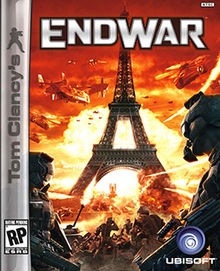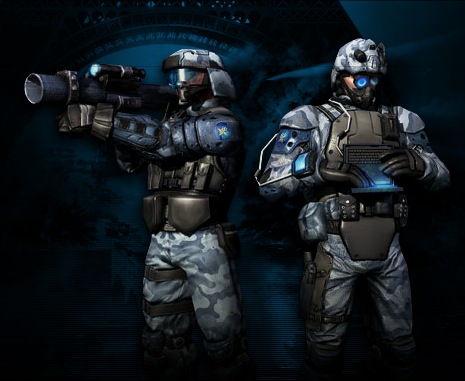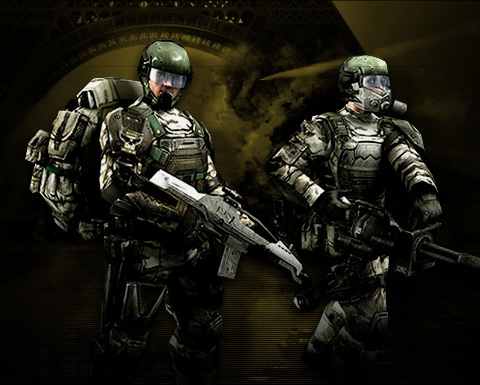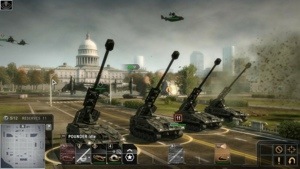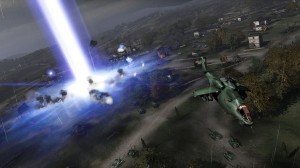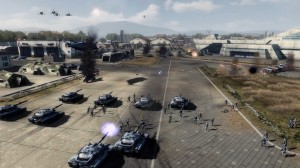Reflection: “End War” (from Ubisoft)
End War, from Ubisoft Shanghai, stands out for me as an excellent example of strategic and tactical game play and appropriate technology. Sadly, it has always seemed to me to get short shrift in reviews and consideration.
Before getting started, a quick reminder of a few of my critical baseline considerations of any strategy game.
In looking over many End War reviews, I cannot escape the feeling that only the scantest of understandings went into the consideration. They mostly cite the way the units have a rock-paper-scissors set up, which is well, true…and taken straight from the games own instructions and marketing materials. Still, this belies the rest of the design and all of the fun.
The rock-paper-scissors of helicopter – tank- transport is just the start. Firstly, there are two different kinds of foot soldiers: infantry and engineers. Secondly, there is artillery. Thirdly, there are special abilities that can be unlocked, or opened up, through capturing on-map strategic points.
The infantry and engineers can really mix up the supposed rock-paper-scissors due to their special abilities in cover and in movement. For example, when infantry is moving through cover they are firstly harder to discover and second enjoy stat advantages. This is especially true when they are buildings. A smart commander will station tanks (weak against helicopters) outside a building that is hiding engineers or even infantry inside. This is also a good example of the distinct yet complimentary principle. Similarly, a transport (weak against tanks) can race up to a strategic zone and deposit engineers in surrounding buildings. When an opponent comes to take the zone, they can easily ambush them, regardless of their position in the rock-paper-scissors cycle. The two types main differences are that infantry trumps engineers in buildings (giving you a way to deal with them head on) and engineers can lay various kinds of traps (e.g. minefields or armed drones). These few examples illustrate how the three-way baseline is much expanded by the distinct yet complimentary approach, which then delivers greater results in the strategic consideration.
Artillery in End War works excellently. Artillery units can fire on practically any position on the map, with decreasing accuracy for distance and absence of spotters. Even so, when shells begin raining down on your troops, its never a good thing! Therefore, it can make a good denial tool by simply setting up a bombardment of a strategic point, making it harder for foot soldiers to approach and capture it. Even better, when teamed up with spotting units, it can greatly weaken or destroy just about any other unit (excepting helicopters, of course). So, teaming up a group of infantry in a building overlooking some strategic zone is a great way to keep your opponents guessing because they won’t know exactly why they’re being fired at. Speaking of infantry, once you do find those guys in the building, artillery is a good way to deal with them. Without risking going face-to-face, just bring the building down around them!
As if these weren’t enough to reconsider the rock-paper-scissors, there are the special abilities. Whenever you capture a strategic zone, you have the option to upgrade it in several ways. For example, electronic warfare, air strikes or force recon (i.e. force support). For an artillery lover like me, the air strikes provide yet another way to take out units or positions with fly by bombings. Still, opponents have often used electronic warfare on me to blind my forward units and keep my fire from being very effective. Trumping even these are the weapons of mass destruction, of course. Still, I think that rather than being about breaking the threesome, they’re more about recovering from setbacks, so more on them below.
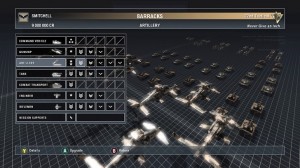
Spend credits to upgrade units, make sure they survive: only experienced units can use the upgrades you purchased
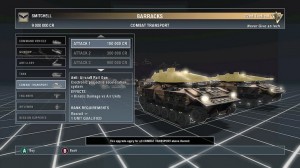
Spend credits to upgrade units, sure. But survival is important – only experienced units can make use of them.
One final way that not only further breaks the rock-paper-scissors review problem but also overall brings the whole thing comes together is the way your army is upgraded. As you play along, you are given credits. Spend the credits on upgrading units according to your play style. Each unit type gets its own unique blend of advantages. For example, helicopters get better attacks and defenses, evening out the advantages the transports enjoy. These upgrades are also faction specific, and can extend the ‘history’ of your faction (e.g. Europeans enjoy electronic warfare in addition to their speedier movement, etc.). The unit upgrades are balanced by individual unit experience levels. That is to say, if the unit in question has not survived enough battles, it cannot use the upgrades. This means commanders become very interested in seeing their people survive, which is not only an addition to ‘history’ fun, but also strongly adds to the ‘organic’ feeling of the game.
Any way you slice it, it is way more than simple rock-paper-scissors and opens up many strategic and tactical choices.
Speaking of strategy, the game provides three factions which are well balanced, yet distinct. Where Europeans rely on speed and precision, the US relies on stealth and surprise and Russians rely more on brute strength. Each faction has very balanced advantages and disadvantages which make selecting your strategy and the units to match a lot of fun. The ability to adjust to set backs by calling in different types of units or make radical leaps just makes it more fun and rewarding. The example that got the most press is the “Weapons of Mass Destruction” option, either a ray from satellites, or huge-mass drop from space. And while that certainly can help you recover and change the balance, it also opens the option for opponents’ retaliation. This makes for a tough decision from time to time. Should you hit the opponents with a trump card? Knowing that they’ll simply drop theirs on you? Or should you keep fighting the Good Fight and trust in your strategy? If you find yourself in a match with me, you can know that I won’t usually drop the Big One unless its really, really the last option. Call it spite, if you must. I call it “retribution.”
For another example allowing recovery from a set back, one of my favorite moves as the US is to use the long-range deployment of infantry. Typically battle lines form as the two battle groups come together. This means that attention is directed at that point – especially when I am losing and the opponent is winning. I usually attempt to take advantage of this by using the “Deep Strike” ability of certain infantry and deploying them next to a rear area strategic zone. The sudden and unexpected loss of a zone far to the rear, often bringing with it the weakening of one of the special abilities, usually forces a retreat and reconsideration, which means I can roll forward, turning weakness to strength. This sort of situation is an excellent example of the ability to recover from a set back with a calculated risk.
As for the interface, I am not exaggerating: it’s one of the best ever. How can you fault a system where you literally, with your voice, tell the units what to do…and they do?! Using the controller like a walkie talkie, pulling the trigger to talk and issue orders, is a stroke of genius. I have personally never had any problems with being recognized, but did experience some issues with younger players whose voice was either too high pitched or perhaps too quiet to be understood clearly. Even so, there are quick and easy ways to access all the same commands using the bumper and buttons. The units and special abilities are all represented by ‘cards’ onscreen which can be selected and directed easily. The cards provide all kinds of useful information, like who is firing, who is under fire, how much damage has been taken and so on. All together, it means that whether you think faster with voice or with fingers or both, you’re always covered. In any case, talking to your units really brings a strong underscoring of an “organic” feel. There is a sort of connection that is much harder to achieve with mice, keyboards or controllers.
The look and feel for me is also nearly perfect. While you could play the game entirely in “sit rep” mode, where you see simple representations of your units on a tactical map, its much more fun to zoom around the environment and watch closer up. Still, the way the camera zooms across the environment and allows for rotation and so on means you can always keep a good eye on your units and the action. If you’re in the mood for a ride, just follow one of the units (with a ‘go to’ command) and the camera will center on it as it moves along, storms a building or attacks a strategic zone. All good fun!
I greatly enjoy multiplayer, both co-op and “asynchronous massively multi-player.” The way individual battles over particular maps is updated on the overall global war is great, and allows for a lot of play without feeling repetitive. Co-op is also fun, but it is the one area where I feel implementation fell down. That is because communicating and coordinating with your partner is not easy at all. Because of the voice activation, you cannot leave a chat channel open and work together that way. Sadly, the designers apparently didn’t consider creating a similar walkie-talkie approach for communicating with teammates. I mean, why not one of the bumpers or triggers to send a message to your partner. So, you’re left first discussing some plans and then giving it a go. Sadly, since no plan survives meeting the enemy, when you begin making changes, you can’t notify your teammate!
Having said all that, the matches are timed and the units balanced enough that matches indeed last only 20 minutes or so. This means you can easily play three matches in an hour. I think this is about perfect because you come away from a play session (for me, that is one or two hours, hopefully!) having either really learned or accomplished something. That is to say, you either saw new strategies and figured out new ways to play or you were winning. Either way, good fun!
In short, End War continues to provide hours of fun. While other games released at the same time have gone onto the shelf, End War finds itself in my XBox regularly. I play it with friends both competitively and cooperatively, and even with the kids (who also love it for many of the reasons mentioned above, something about acorns falling near the tree?).
